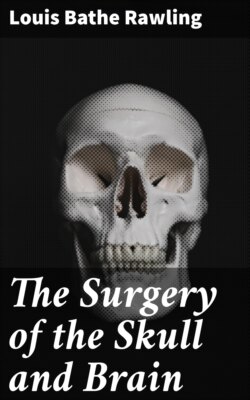Читать книгу The Surgery of the Skull and Brain - Louis Bathe Rawling - Страница 33
На сайте Литреса книга снята с продажи.
Craniectomy.
ОглавлениеAfter the application of protective gauze and tourniquet, the scalp-flap is framed according to the requirements of the case. If the tourniquet is used, the knife is entered at one extremity of the proposed flap, carried down to the bone—through gauze and scalp in one—and the incision completed in a single sweep. Under other circumstances, digital pressure is applied to the main flap-supplying vessel, e.g. the temporal artery over the base of the zygoma, or else Kredel’s clamps or Vorschütz’s hæmostatic safety-pins are passed in such a manner as to control bleeding from the main supplying vessel. In the event of bleeding, the surgeon goes along quietly, deepening his incision and seizing each vessel as exposed.
In turning down the scalp-flap it is usually recommended that the pericranium should be included. This is quite unnecessary, and, under certain circumstances, should certainly be omitted (see p. 129). It should be stripped away from the underlying bone as required.
Fig. 7. Hudson’s Trephine. Showing the usual method of using the spiral perforator, spiral follower, and enlarging burr.
The trephining may be carried out with the hand-trephine, or by means of saws, burrs, and trephines driven by electricity. With the exception of a few words on Hudson’s trephine, I do not propose to discuss the relative advantages and disadvantages of these mechanically-driven instruments. I hold the opinion that the hand-driven instrument is sufficiently rapid in its work, that it is infinitely safer, and that the surgeon should accustom and perfect himself with those instruments which are to him most convenient and most portable. He will not always be conducting his operations in a perfectly equipped hospital, much of his work will be carried out in the nursing home or in the country. Whatever method be adopted, the operator should use those instruments to which he is most accustomed.
Hudson’s trephine is shaped after the style of the carpenter’s brace and is fitted with three cutting heads—the perforator, the follower, and the enlarging burr. It is claimed that injury to the dura and brain is impossible, the instrument becoming automatically locked so soon as the resistance of the internal table is overcome, a thin film of bone being pushed in front of the advancing head. I have had the opportunity of using this instrument, and so far as my experience goes it answers all requirements. Still, I prefer the ordinary hand-trephine so long as it satisfies certain requirements. It must be of simple mechanism and strong, the handle of good size and shaped to fit the hand, the shaft and head so interlocked as to allow of no independent movement, and the hollow head sharply toothed and bevelled externally, in continuity with the teeth, for a distance of half an inch. The bevelling is so arranged that the actual cutting process is only effected during supination of the hand and forearm. The pin of the trephine should not project beyond the cutting edge for a greater distance than about ·2cm. This pin should be readily removable.
Fig. 8. The Hand-trephine.
The pattern which I am accustomed to use is depicted in Fig. 8. The trephines are kept in three sizes—diameter 1⁄2, 1, and 11⁄2 inches. The intermediate size is used for ordinary trephining, the small one for the formation of the osteoplastic flap, the large for the removal of a disk of bone which includes within its circumference the area involved in some depressed and punctured fractures (see p. 133).
Fig. 9.
Fig. 10.
To show the technique of Trephining. Fig. 9 illustrates the act of trephining for cerebellar exposure. Fig. 10 shows a trephine-disk to one side of a depressed fracture.
The site of trephining may be fixed by the introduction of a bradawl through the scalp, so indenting the external table that the spot can be verified on turning down the scalp-flap. The pin of the trephine is there applied, and the trephine directed at right angles to the surface of the skull, or at that angle which is suited to the region attacked. The pin is discarded when a sufficient groove has been attained. The trephine must be kept under perfect control, muscular effort only being required during the act of supination.
Fig. 11. Horsley’s Disk or Bone Elevator.
Fig. 12. Horsley’s Dural Separator.
Fig. 13. Keen-Hoffmann’s Craniectomy Forceps.
The firm nature of the external table will be readily appreciated; so soon as this resistance is overcome the trephine will be felt to be cutting its way through a softer structure, whilst the increased bone-dust and venous oozing will make it evident that the instrument is biting its way through the diploic tissue. Greater resistance is again encountered on meeting the internal table, warning the operator that the time has come when greater care must be exercised. The bone-dust must be wiped away, the teeth of the trephine cleansed with nail-brush or sponge, and the depth of the groove estimated. The groove should be of the same depth throughout its circumference, or of that depth which is suited to the part involved.
The readiness of the disk for removal is best demonstrated by digital pressure. When it gives to that pressure, whether in whole or in part, the elevator may be applied and the fragment removed.
In the temporal and cerebellar regions special care is required by reason of the absence of diploic tissue.
It is impossible to lay too much stress on the necessity of avoiding injury to underlying dura and meningeal vessels. Injury to these structures not infrequently upsets the whole plan of campaign.
Fig. 14.
Lane’s Fulcrum Craniectomy Forceps.
Fig. 15.
Horsley’s Gouge Forceps.
Fig. 16. De Vilbiss’s Craniectomy Forceps.
